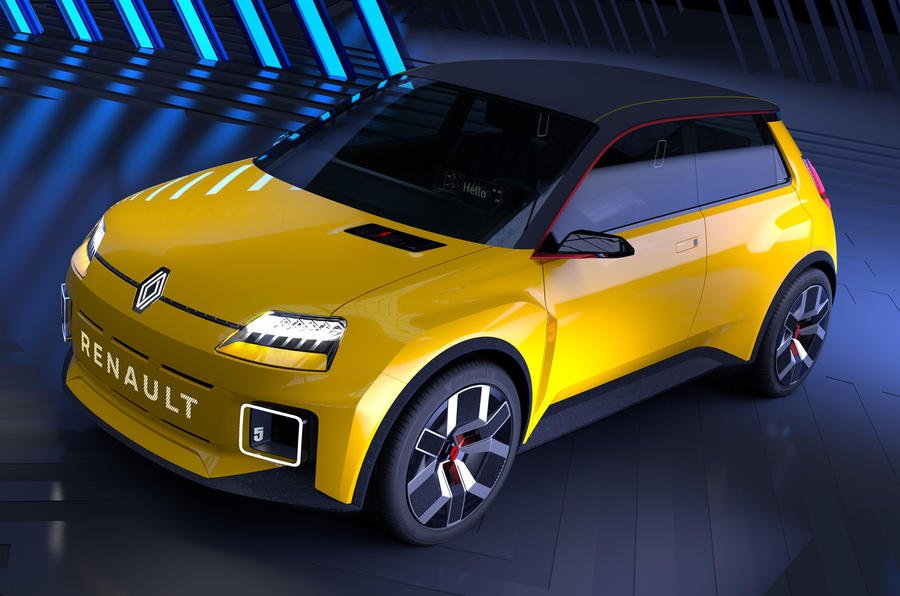The new Renault 5 electric hatchback is set to cost around £18,500 when it goes on sale in 2024.
The revived nameplate will be part of a major new plan to revive the French firm's fortunes and will sit on the Renault Group's new CMF-BEV platform for small electric cars.
Speaking during a Renault electropop event, company boss Luca de Meo said the use of the new platform and revamped battery tech will enable the firm to sell the 5 for about 33% less than a current Zoe. With an entry-level Zoe costing £27,505, that suggests a target starting price for the 5 of around £18,500.
The firm has also confirmed the new 5 will use new powertrain technology and nickel, manganese and cobalt-based (NCM) batteries that, it says, will dramatically reduce the cost per kWh to around £58 by 2030. Renault added that the 5 will have a range of around 400km (248 miles).
The Renault 5 Prototype pictured here takes styling and design cues from the Clio’s predecessor that Renault produced from 1972 to 1996. It's set to be one of 14 new models – including seven fully electric vehicles – that the French brand will launch by 2025.
It will also be joined by a new version of the Renault 4 supermini, called the 4ever.
The French firm originally revealed the new 5 concept during the unveiling of the ‘Renaulution’ strategic plan devised by new boss Luca de Meo. The 5 Prototype city car will be a key part of Renault’s push for 30% of its sales to be of electric vehicles by 2025.
De Meo, who during his time at Fiat was key in reviving the 500, said: “I know from experience that reinventing a cult products lights a fire under the whole brand. This is a cult vehicle at a price many can afford. And this is only the beginning for the whole Renault brand.”
The Renault 5 Prototype is an electric-only model, with a design that features numerous references to various versions of the original 5, including the cult classic Supercinq and R5 Turbo versions, albeit given a modern EV twist. The front headlights are modelled on the original design, while there's a front-mounted EV charging port located where the radiator grille was placed on the original.
Renault design chief Gilles Vidal said: “The design of the Renault 5 Prototype is based on the R5, a cult model of our heritage. This prototype simply embodies modernity, a vehicle relevant to its time: urban, electric, attractive.”
Renault has yet to confirm when the production version of the Concept 5 will go on sale or give full technical specifications.
The showcase features wider rear wheel arches and a red stripe livery that nods to the R5 Turbo hot hatch, hinting at the prospect of a high-performance version of the new model.
Beyond the commitment to launch seven new EVs worldwide by 2025, no timeline has been given for when the 5 EV might go into production. Described as a city car, the model could replace the hugely successful Zoe EV as the firm’s compact electric hatch, and which would likely be due for replacement around then.
Renault last year revealed the Mégane eVision, an electric SUV that will go into production next year as the first car built on the CMF-EV platform.
The history of the Renault 5
The original Renault 5 was launched in 1972, designed to fill the sizeable gap between the Renault 4 and the Citroën 2CV in the French small car market. Renault engineers were given a brief to develop a small car that would meet the needs of the widest range of the French car buying public possible.
The final design remained close to the original sketches from designer Michel Boue, with a slightly unconventional design. Under the bodywork, the R5 used many of the mechanicals from the Renault 4 and Renault 6 and featured front-wheel-drive with a choice of two engines.
The car was a huge hit: by 1980, it was one of the best-selling cars in the world. In 1976, it also spawned the Renault 5 Alpine (branded the 5 Gordini in the UK), one of the world’s first true hot hatches.
That was followed in 1980 by the R5 Turbo, a cult classic rally homologation special that featured a mid-mounted turbocharged engine in the passenger compartment behind the driver.
The second generation of the 5, known as the Supercinq, was launched in 1984 with a revised look and built on a new platform. It was effectively replaced as Renault’s lead supermini by the Clio, which was launched in 1990, although the Supercinq remained on sale in some markets until 1996.

